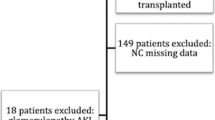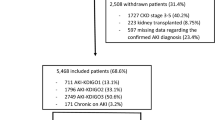Abstract
Evidence regarding hospital-based acute kidney injury (AKI) reveals a continuous increase in incidence over the years, at least in intensive care units (ICU). Fewer reports are available for non critically-ill patients admitted to general or specialist wards other than ICU (non-ICU). The consequence of greater incidence is an increase in therapies such as dialysis; but how the health care organization deals with this problem is not clearly known. Here we quantified the incidence of dialysis-requiring AKI (AKI-D) among patients admitted to a University Hospital which serves a population of 354,000 inhabitants. Between 2007 and 2012, the incidence of AKI-D increased from 209 to 410 per million population (pmp)/year; age of patients and cardiovascular comorbid pathologies also increased. AKI-D was more frequent in non-ICU and 32 % of patients were admitted to ICU. Considering the site of treatment of non-ICU patients, in 2007 the ratio of patients admitted to non-ICU wards apart from Nephrology to those admitted to Nephrology was 1:1, but in 2012 the ratio increased to 2.4:1 (p < 0.05). The complexity of acute disease, measured with the New Simplified Acute Physiology Score (SAPS II), did not reveal differences over the years. The number of dialysis treatments/year increased by 82 %, and the total hours/year increased by 86 %. Low-efficiency daily dialysis was performed in 52.4 % of patients admitted to ICU, but dialysis sessions longer than 8 h were performed in only 40 % of cases. Overall, 6-year mortality was 48.8 %, without significant differences over the years. Mortality in ICU was 65.6 %, and in non-ICU 41.2 % (p < 0.001). Dialysis treatments needed to be continued after hospital discharge in 21 % of patients. We conclude that dialysis-requiring AKI is becoming more common, and that two-thirds of patients are admitted as non-ICU: in these patients, during the last year of the study, the treatment site was more frequently in non-ICUs other than Nephrology. Over the 6-year period, the local healthcare organization had to dispense 80 % more dialysis treatments/year in terms of total number and hours of treatment. One-fifth of surviving patients needed to continue dialysis after hospital discharge. Our data highlight the public health importance of AKI and the need for adequate resources for Nephrology.



Similar content being viewed by others
References
Hsu CJ (2010) Where is the epidemic in kidney disease? J Am Soc Nephrol 21:1607–1611
Susantitaphong P, Cruz DN, Cerda J et al (2013) World incidence of AKI: a meta-analysis. Clin J Am Soc Nephrol 8:1482–1493
Zappitelli M, Parick CR, Akcan-Arikan A et al (2008) Ascertainment and epidemiology of acute kidney injury varies with definition interpretation. Clin J Am Soc Nephrol 3:948–954
Waikar SS, Curhan GC, Wald R et al (2006) Declining mortality in patients with acute renal failure 1988 to 2002. J Am Soc Nephrol 17(4):1143–1150
Hsu RK, McCulloc CE, Dudley A et al (2013) Temporal changes in incidence of dialysis-requiring AKI. J Am Soc Nephrol 24:37–42
Bagshaw SM, Laupland KB, Doig CJ et al (2005) Prognosis for long-term survival and renal recovery in critically ill patients with severe acute renal failure: a population-based study. Crit Care 9:R700–R709. doi:10.1186/cc3879
Lafrance JP, Miller DR (2010) Acute kidney injury associates with increased long-term mortality. J Am Soc Nephrol 21:345–352
Van Berendoncks AM, Elseviers MM, Lins RL, For the SHARF study group (2010) Outcome of acute kidney injury with different treatment options: long-term follow-up. Clin J Am Soc Nephrol 5:1755–1762
Hsu C-y, Chertow GM, McCulloc CE et al (2009) Nonrecovery of kidney function and death after acute on chronic renal failure. Clin J Am Soc Nephrol 04:891–898
Ng KP, Chanouzas D, Fallouh B et al (2012) Short and long-term outcome of patients with severe acute kidney injury requiring renal replacement therapy. Q J Med 105:33–39
Shiffl H, Lang SM, Fischer R (2012) Long-term outcomes of survivors of ICU acute kidney injury requiring renal replacement therapy: a 10-year prospective cohort study. Clin Kidney J 5:297–302
Bellomo R, Ronco C, Kellum JA et al (2004) Acute renal failure––definition, outcome measures, animal models, fluid therapy and information technology needs: the second international consensus conference of the Acute Dialysis Quality Initiative (ADQI) Group. Crit Care 8(4):R204–R212
Liano F, Pascual J, The Madrid Acute Renal Failure Study Group (1996) Epidemiology of acute renal failure: a prospective, multicenter, community-based study. Kidney Int 50:811–818
Società Italiana di Nefrologia. Italian Registry of Dialysis and Transplantation. Available at: http://www.sin-ridt.org/sin-ridt.org.htm. Accessed 13 Dec 2013
C-y Hsu, McCulloch CE, Fan D et al (2007) Community-based incidence of acute renal failure. Kidney Int 72:208–212
Khan IH, Catto GRD, Edward N et al (1997) Acute renal failure: factors influencing nephrology referral and outcome. Q J Med 90:781–785
Feest TG, Round A, Hamad S (1993) Incidence of severe acute renal failure in adults: results of a community based study. BMJ 306:481–483
Metcalfe W, Simpson M, Khan IH et al (2002) Acute renal failure requiring renal replacement therapy: incidence and outcome. Q J Med 95:579–583
Prescott GJ, Metcalfe W, Baharani J et al (2007) A prospective national study of acute renal failure treated with RRT: incidence, aetiology and outcomes. Nephrol Dial Transpl 22:2513–2519
Hegarty J, Middleton RJ, Krebs M et al (2005) Severe acute renal failure in adults: place of care, incidence and outcomes. Q J Med 98:661–666
Baharani J, Martin H, Lawson L et al (2002) The epidemiology of acute renal failure in Scotland. Scottish Executive Health Department Chief Scientist Office, Focus on Research
Mariano F, Pozzato M, Canepari G et al (2011) Renal replacement therapy in intensive care units: a survey of nephrological practice in northwest Italy. J Nephrol 24:165–176
Ali T, Khan I, Simpson W et al (2007) Incidence and outcome in acute kidney injury: a comprehensive population-based study. J Am Soc Nephrol 18:1292–1298
Hsu CY, Ordonez JD, Certow GM et al (2008) The risk of acute renal failure in patients with chronic kidney disease. Kidney Int 74:101–107
Abelha FJ, Botelho M, Fernandes V et al (2009) Determinants of postoperative acute kidney injury. Crit Care 13:R79. doi:10.1186/cc7894
Drawz PE, Miller RT, Sehgal AR (2008) Predicting hospital-acquired acute kidney injury––a case-controlled study. Ren Fail 30:848–855
Lapi F, Azoulay L, Yin H, Nessim SJ et al (2013) Current use of diuretics, angiotensin converting enzyme inhibitors, and angiotensin receptors blockers with non-steroidal anti-inflammatory drugs and risk of acute kidney injury: nested case-control study. BMJ 346:e8525
Del Giudice A, Aucella F (2012) Acute renal failure in the elderly: epidemiology and clinical features. J Nephrol 25:S48–S57
Abraham KA, Thompson EB, Bodger K et al (2012) Inequalities in outcomes of acute kidney injury in England. Q J Med 105:729–740
James MT, Wald R, Bell CM et al (2010) Weekend hospital admission, acute kidney injury, and mortality. J Am Soc Nephrol 21:845–851
Handel A, Patel SV, Skingsley A et al (2012) Weekend admissions as an independent predictor of mortality: an analysis of Scottish hospital admissions. BMJ Open 2:e001789. doi:10.1136/bmjopen-2012-001789
Uchino S, Kellum JA, Bellomo R et al (2005) Acute renal failure in critically ill patients: a multinational, multi center study. JAMA 294:813–818
Bagshaw SM, George C, Bellomo R et al (2008) A comparison of the RIFLE and AKIN criteria for acute kidney injury in critically ill patients. Nephrol Dial Transpl 23:1569–1574
Clec’h C, Gonzalez F, Lautrette A et al (2011) Multiple-center evaluation of mortality associated with acute kidney injury in critically ill patients: a competing risks analysis. Crit Care 15:R128. doi:10.1186/cc10241
Conflict of interest
On behalf of all authors, the corresponding author states that there is no conflict of interest.
Author information
Authors and Affiliations
Corresponding author
Rights and permissions
About this article
Cite this article
Fagugli, R.M., Patera, F., Battistoni, S. et al. Six-year single-center survey on AKI requiring renal replacement therapy: epidemiology and health care organization aspects. J Nephrol 28, 339–349 (2015). https://doi.org/10.1007/s40620-014-0114-8
Received:
Accepted:
Published:
Issue Date:
DOI: https://doi.org/10.1007/s40620-014-0114-8




